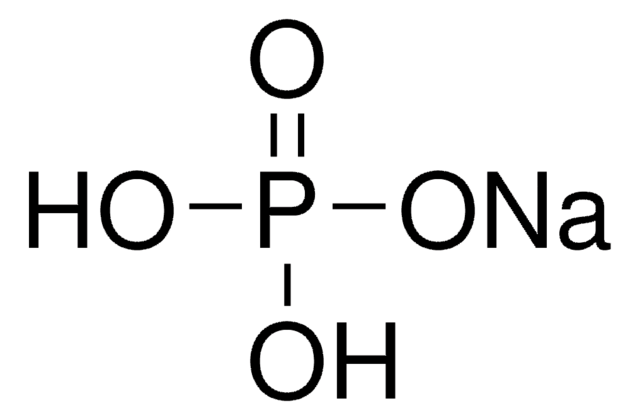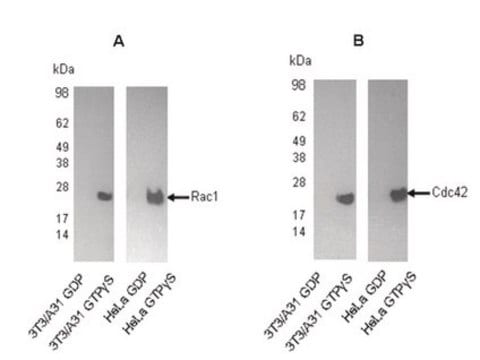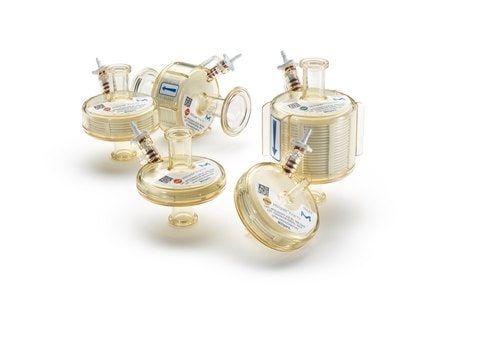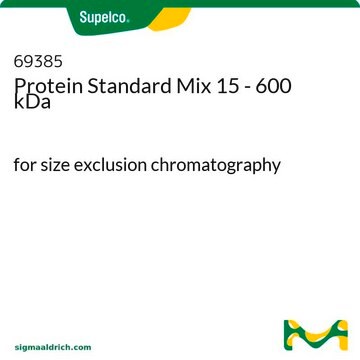S7811
CPGWIZ™ hMLH1 - Methylation specific PCR assay
Se connecterpour consulter vos tarifs contractuels et ceux de votre entreprise/organisme
About This Item
Code UNSPSC :
12161503
eCl@ss :
32161000
Nomenclature NACRES :
NA.84
Produits recommandés
Description générale
FUNCTION: SwissProt: P40692 # Involved in the repair of mismatches in DNA.
SIZE: 756 amino acids; 84601 Da
SUBUNIT: Heterodimer of MLH1 and PMS2 or MLH1 and MLH3. Part of the BRCA1-associated genome surveillance complex (BASC), which contains BRCA1, MSH2, MSH6, MLH1, ATM, BLM, PMS2 and the RAD50- MRE11-NBS1 protein complex. This association could be a dynamic process changing throughout the cell cycle and within subnuclear domains. Interacts with MBD4. Interacts with EXO1.
SUBCELLULAR LOCATION: Nucleus.
TISSUE SPECIFICITY: Colon, lymphocytes, breast, lung, spleen, testis, prostate, thyroid, gall bladder and heart.
DISEASE: SwissProt: P40692 # Defects in MLH1 are the cause of hereditary non-polyposis colorectal cancer type 2 (HNPCC2) [MIM:609310]. Mutations in more than one gene locus can be involved alone or in combination in the production of the HNPCC phenotype (also called Lynch syndrome). Most families with clinically recognized HNPCC have mutations in either MLH1 or MSH2 genes. HNPCC is an autosomal, dominantly inherited disease associated with marked increase in cancer susceptibility. It is characterized by a familial predisposition to early onset colorectal carcinoma (CRC) and extra-colonic cancers of the gastrointestinal, urological and female reproductive tracts. HNPCC is reported to be the most common form of inherited colorectal cancer in the Western world, and accounts for 15% of all colon cancers. Cancers in HNPCC originate within benign neoplastic polyps termed adenomas. Clinically, HNPCC is often divided into two subgroups. Type I: hereditary predisposition to colorectal cancer, a young age of onset, and carcinoma observed in the proximal colon. Type II: patients have an increased risk for cancers in certain tissues such as the uterus, ovary, breast, stomach, small intestine, skin, and larynx in addition to the colon. Diagnosis of classical HNPCC is based on the Amsterdam criteria: 3 or more relatives affected by colorectal cancer, one a first degree relative of the other two; 2 or more generation affected; 1 or more colorectal cancers presenting before 50 years of age; exclusion of hereditary polyposis syndromes. The term suspected HNPCC or incomplete HNPCC can be used to describe families who do not or only partially fulfill the Amsterdam criteria, but in whom a genetic basis for colon cancer is strongly suspected. & Defects in MLH1 are a cause of Turcot syndrome [MIM:276300]. Turcot syndrome is an autosomal dominant disorder characterized by malignant tumors of the brain associated with multiple colorectal adenomas. Skin features include sebaceous cysts, hyperpigmented and cafe au lait spots. & Defects in MLH1 are a cause of Muir-Torre syndrome (MTS) [MIM:158320]. MTS is a rare autosomal dominant disorder characterized by sebaceous neoplasms and visceral malignancy. & Defects in MLH1 may contribute to lobular carcinoma in situ (LCIS), a non-invasive neoplastic disease of the breast. & Defects in MLH1 are a cause of susceptibility to endometrial cancer [MIM:608089].
SIMILARITY: SwissProt: P40692 ## Belongs to the DNA mismatch repair mutL/hexB family.
SIZE: 756 amino acids; 84601 Da
SUBUNIT: Heterodimer of MLH1 and PMS2 or MLH1 and MLH3. Part of the BRCA1-associated genome surveillance complex (BASC), which contains BRCA1, MSH2, MSH6, MLH1, ATM, BLM, PMS2 and the RAD50- MRE11-NBS1 protein complex. This association could be a dynamic process changing throughout the cell cycle and within subnuclear domains. Interacts with MBD4. Interacts with EXO1.
SUBCELLULAR LOCATION: Nucleus.
TISSUE SPECIFICITY: Colon, lymphocytes, breast, lung, spleen, testis, prostate, thyroid, gall bladder and heart.
DISEASE: SwissProt: P40692 # Defects in MLH1 are the cause of hereditary non-polyposis colorectal cancer type 2 (HNPCC2) [MIM:609310]. Mutations in more than one gene locus can be involved alone or in combination in the production of the HNPCC phenotype (also called Lynch syndrome). Most families with clinically recognized HNPCC have mutations in either MLH1 or MSH2 genes. HNPCC is an autosomal, dominantly inherited disease associated with marked increase in cancer susceptibility. It is characterized by a familial predisposition to early onset colorectal carcinoma (CRC) and extra-colonic cancers of the gastrointestinal, urological and female reproductive tracts. HNPCC is reported to be the most common form of inherited colorectal cancer in the Western world, and accounts for 15% of all colon cancers. Cancers in HNPCC originate within benign neoplastic polyps termed adenomas. Clinically, HNPCC is often divided into two subgroups. Type I: hereditary predisposition to colorectal cancer, a young age of onset, and carcinoma observed in the proximal colon. Type II: patients have an increased risk for cancers in certain tissues such as the uterus, ovary, breast, stomach, small intestine, skin, and larynx in addition to the colon. Diagnosis of classical HNPCC is based on the Amsterdam criteria: 3 or more relatives affected by colorectal cancer, one a first degree relative of the other two; 2 or more generation affected; 1 or more colorectal cancers presenting before 50 years of age; exclusion of hereditary polyposis syndromes. The term suspected HNPCC or incomplete HNPCC can be used to describe families who do not or only partially fulfill the Amsterdam criteria, but in whom a genetic basis for colon cancer is strongly suspected. & Defects in MLH1 are a cause of Turcot syndrome [MIM:276300]. Turcot syndrome is an autosomal dominant disorder characterized by malignant tumors of the brain associated with multiple colorectal adenomas. Skin features include sebaceous cysts, hyperpigmented and cafe au lait spots. & Defects in MLH1 are a cause of Muir-Torre syndrome (MTS) [MIM:158320]. MTS is a rare autosomal dominant disorder characterized by sebaceous neoplasms and visceral malignancy. & Defects in MLH1 may contribute to lobular carcinoma in situ (LCIS), a non-invasive neoplastic disease of the breast. & Defects in MLH1 are a cause of susceptibility to endometrial cancer [MIM:608089].
SIMILARITY: SwissProt: P40692 ## Belongs to the DNA mismatch repair mutL/hexB family.
Application
Principles of the Technique
Use of either the CpGenome DNA Modification Kit (Cat. No. S7820) or the CpGenome Fast DNA Modification Kit (Cat. No. S7824) facilitates the initial bisulfite reactions, while the TM=["CPGWIZ"] HMLH1 Amplification Kit contains the reagents required for the gene-specific PCR amplification reactions.
Use of either the CpGenome DNA Modification Kit (Cat. No. S7820) or the CpGenome Fast DNA Modification Kit (Cat. No. S7824) facilitates the initial bisulfite reactions, while the TM=["CPGWIZ"] HMLH1 Amplification Kit contains the reagents required for the gene-specific PCR amplification reactions.
Composants
The components of the CPG WIZ hMLH1 Amplification Kit include those required for PCR amplification after bisulfite modification of DNA samples. Sufficient reagents are provided to analyze 25 samples with appropriate controls. U Primer Set7.5 μM each primer (25X) 35 μL (neutral cap) 90563 -15°C to -25°C M Primer Set7.5 μM each primer (25X) 35 μL (red cap) 90564 -15°C to -25°C W Primer Set7.5 μM each primer (25X) 35 μL (green cap) 90565 -15°C to -25°C U control DNA0.1 μg/μL 50 μL (white cap) 90393 -15°C to -25°C M control DNA0.1 μg/μL 50 μL (red cap) 90394 -15°C to -25°C W control DNA0.05 μg/μL 50 μL (green cap) 90395 -15°C to -25°C Universal 10X PCR Buffer 265 μL (blue cap) 90396 -15°C to -25°C
Informations légales
CPGWIZ is a trademark of Merck KGaA, Darmstadt, Germany
Clause de non-responsabilité
Unless otherwise stated in our catalog or other company documentation accompanying the product(s), our products are intended for research use only and are not to be used for any other purpose, which includes but is not limited to, unauthorized commercial uses, in vitro diagnostic uses, ex vivo or in vivo therapeutic uses or any type of consumption or application to humans or animals.
Code de la classe de stockage
10 - Combustible liquids
Certificats d'analyse (COA)
Recherchez un Certificats d'analyse (COA) en saisissant le numéro de lot du produit. Les numéros de lot figurent sur l'étiquette du produit après les mots "Lot" ou "Batch".
Déjà en possession de ce produit ?
Retrouvez la documentation relative aux produits que vous avez récemment achetés dans la Bibliothèque de documents.
Notre équipe de scientifiques dispose d'une expérience dans tous les secteurs de la recherche, notamment en sciences de la vie, science des matériaux, synthèse chimique, chromatographie, analyse et dans de nombreux autres domaines..
Contacter notre Service technique







